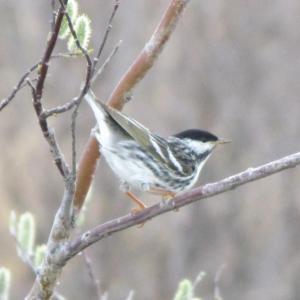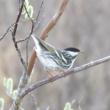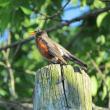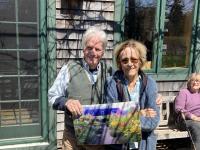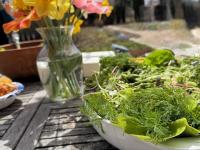The Late-Arriving Blackpoll Warbler
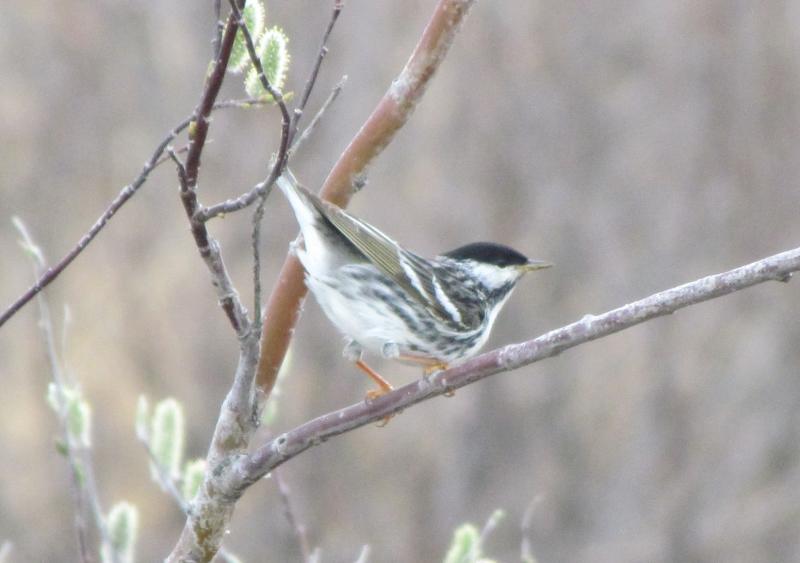 Blackpoll warblers are one of the last migrants to appear each spring as they travel all the way from South American wintering grounds. The males are distinctive when you see them, with their black cap and yellow legs, but often the only giveaway to their presence is their squeaky brake song. Courtesy of Jeff Wells.
Blackpoll warblers are one of the last migrants to appear each spring as they travel all the way from South American wintering grounds. The males are distinctive when you see them, with their black cap and yellow legs, but often the only giveaway to their presence is their squeaky brake song. Courtesy of Jeff Wells.
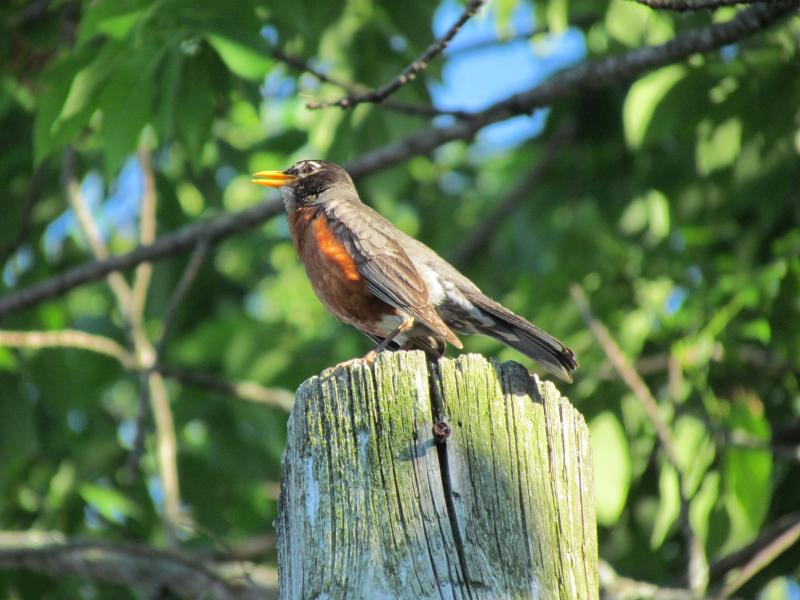 American robins are one of the earlier spring migrants as they are short-distance migrants. They can easily speed up their arrival under warming conditions and subsequently also can speed up the onset of nesting. Courtesy of Jeff Wells.
American robins are one of the earlier spring migrants as they are short-distance migrants. They can easily speed up their arrival under warming conditions and subsequently also can speed up the onset of nesting. Courtesy of Jeff Wells.
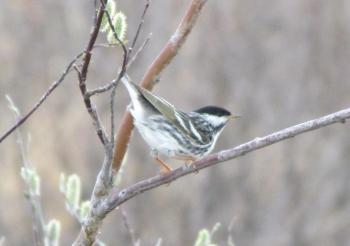 Blackpoll warblers are one of the last migrants to appear each spring as they travel all the way from South American wintering grounds. The males are distinctive when you see them, with their black cap and yellow legs, but often the only giveaway to their presence is their squeaky brake song. Courtesy of Jeff Wells.
Blackpoll warblers are one of the last migrants to appear each spring as they travel all the way from South American wintering grounds. The males are distinctive when you see them, with their black cap and yellow legs, but often the only giveaway to their presence is their squeaky brake song. Courtesy of Jeff Wells.
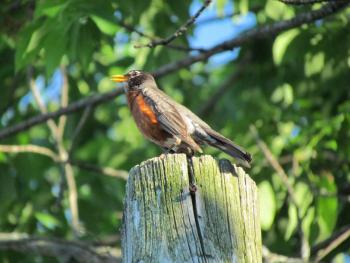 American robins are one of the earlier spring migrants as they are short-distance migrants. They can easily speed up their arrival under warming conditions and subsequently also can speed up the onset of nesting. Courtesy of Jeff Wells.
American robins are one of the earlier spring migrants as they are short-distance migrants. They can easily speed up their arrival under warming conditions and subsequently also can speed up the onset of nesting. Courtesy of Jeff Wells.
The heat was oppressive, like a mid-July day, not like what we are used to on the second day of June here in Maine. But as we stepped outside to walk the dog in the morning, there was an unmistakable squeaky brake sound emanating from the thick, green foliage of the leafed-out trees: “seet-seet-SEET-SEET-seet-seet.” Softer, than louder, as if the sound source were getting closer and then moving away. But it wasn’t. It was the song of one of the most remarkable bird migrants in the world, the blackpoll warbler.
Blackpoll warblers winter far to our south, in northern South America, largely in the Amazon Basin region. Most nest well to our north across the Boreal Forest biome of Canada to Alaska except for a few that frequent the rugged, high elevation mountaintops of New England and New York. Like many of the longest distance migrants, they are one of the species that is the latest to arrive and pass through our area.
There are species that also usher in the last days of spring migration each year—yellow-bellied flycatchers, mourning warblers, and gray-cheeked thrushes, for example. These species, unlike the blackpoll warbler, often pass through seemingly like ghosts, only very occasionally detected by birders. But the blackpoll warbler’s distinctive sound is unmistakable to those who know to listen for it.
We continued on our morning dog walk through the neighborhood that second day of June. We flushed an entire flock of European starlings from the long, green grass as we passed on the sidewalk in front of a neighbor’s house. Most of them bore the unmistakable flat brown coloration characteristic of juveniles that had left the nest a few weeks ago.
We crossed the street and stepped through the gate into the local park. A robin, its breast glowing orange, flashed ahead of us and landed beside the dirt path. A slightly smaller robin with brown spots on its breast hopped toward the adult, loud begging squawks emanating from its open beak: another young bird just out of the nest.
Later, down near the waterfront, a pair of song sparrows followed us, giving agitated chirps, clearly bothered because of their nearby nest with young.
Starlings, robins, and song sparrows arrive (a few may spend the winter) back here in Maine from their winter quarters much earlier in the season. They are short-distance migrants that winter here in the U.S. Research has shown that these birds are better able to track the increasingly early warmer temperatures caused by climate change. They come back sooner (a few weeks earlier than 40 years ago) and get to work raising young when temperature conditions and food supplies are at their peak to feed their young efficiently.
Long-distance migrants, like blackpoll warblers, don’t find the same cues in their tropical wintering range, so they don’t know they should leave earlier. They arrive only a few days earlier than they did decades ago. So our newly arrived blackpoll warbler passed by starlings, robins and song sparrows that had arrived not only arrived earlier but had completely or nearly completed at least one reproductive cycle.
Will long-distance migrants like the blackpoll warbler be able to adapt to these changing conditions and raise young in the warmer conditions they find themselves in? The mismatch of their arrival time and the advance of summer in the north certainly puts their longevity at risk.
One more reason why action to slow climate change is so urgently needed.
Jeffrey V. Wells, Ph.D., is a Fellow of the Cornell Lab of Ornithology and Vice President of Boreal Conservation for National Audubon. Dr. Wells is one of the nation's leading bird experts and conservation biologists. He is a coauthor of the seminal “Birds of Maine” book and author of the “Birder’s Conservation Handbook.” His grandfather, the late John Chase, was a columnist for the Boothbay Register for many years. Allison Childs Wells, formerly of the Cornell Lab of Ornithology, is a senior director at the Natural Resources Council of Maine, a nonprofit membership organization working statewide to protect the nature of Maine. Both are widely published natural history writers and are the authors of the popular books, “Maine’s Favorite Birds” (Tilbury House) and “Birds of Aruba, Bonaire, and Curaçao: A Site and Field Guide,” (Cornell University Press).

